|
|
Radium

|
|
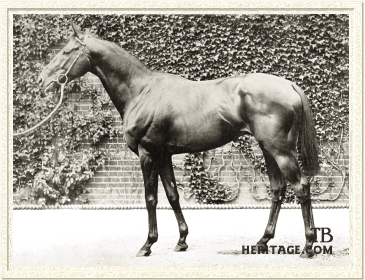 |
|
|
Radium was as classically bred a colt as one could find. His pedigree combined the blood of three of the most famed English studs of the time: that of his breeder, Leopold de Rothschild; the Duke of Westminster's Eaton Stud, and the Duke of Portland's Welbeck Abbey Stud. Radium had six winners of the Epsom Derby in just the first three removes of his family tree. Despite this rich breeding, Radium did not reach his best form until long after his classic season. The wait was worth it, for when he finally did round into his best form, he was recognized as one of the finest stayers of the Edwardian era.
Radium was a muscular bay colt, foaled in 1903. He was bred and raced by Leopold de Rothschild, who enjoyed a long and illustrious tenure as a pillar of the English turf. The Rothschilds, the famed European banking family, had been prominent in Thoroughbred racing in Britain throughout much of nineteenth century. Leopold's uncle, Baron Mayer de Rothschild, campaigned classic winners Mentmore Lass, Tomato, Hannah, Favonius, and Hippia. Leopold's father, Baron Lionel Nathan de Rothschild, owned Derby winner Sir Bevys. Leopold himself, affectionately known by British turf aficionados as "Mr. Leopold," enjoyed classic success with St. Leger winner Doricles, Two Thousand Guineas champion St. Frusquin, and that horse's son, St. Amant, winner of the Two Thousand Guineas and Derby in 1903.
Mentmore Lass, victress in the 1853 One Thousand Guineas, became a foundation mare for the Rothschild breeding program. Mentmore Lass became the dam of Hannah, a King Tom filly named for Baron Mayer de Rothschild's only child, daughter Hannah. This filly captured the One Thousand Guineas, Oaks, and St. Leger in 1871. A full sister to Hannah, the mare Zephyr, produced Favonius, winner of the 1871 Derby for the Baron. Thus, that year, only the Two Thousand Guineas eluded the Rothschild stable. Another full sister to Hannah was the filly Breeze.
Through Breeze, the family continued, as she was the third dam of the three-quarter siblings Galeazzo and Taia. The former, a Galopin colt, garnered victories in the Rous Memorial Stakes at Goodwood and the Chesterfield Nursery Stakes at two and in the Newmarket Biennial Stakes and Newmarket Stakes at three. Galeazzo was sent to the Rothschild stud in France, and from there to Italy, where he proved a successful sire.
Taia, by Galopin's dual classic-winning son Donovan, had no talent on the racecourse, failing to notch a single victory despite being tried over ten times over two seasons. Nevertheless, Leopold de Rothschild held onto her as a broodmare. The wisdom of this over time seemed much in doubt, as Taia produced nothing of merit before Radium was foaled in 1903.
In the spring of 1902, Taia was sent to Eaton Stud to be covered by Bend Or. The magnificent chestnut stallion was twenty-five-years-old and at the very end of his stud career, for he died only one year later. Bred and raced by the first Duke of Westminster, Bend Or, son of Derby winner Doncaster out of Rouge Rose, by Derby and Ascot Gold Cup champion Thormanby, boasted a resume counting victories in the Derby, Epsom Gold Cup and Champion Stakes. As a sire, he became one of the most prominent of his era, his best offspring before Radium including Triple Crown winner Ormonde, Two Thousand Guineas winner Bona Vista, stakes winning colts Kendal, Martagon, Orvieto, Laveno, and Orbit. Unraced daughter Ornament produced the brilliant filly Sceptre, who was still in the midst of her glorious career on the turf when Radium was foaled. Radium was the last top class individual sired by Bend Or.
Radium on the Turf
At two, Radium won the Prince of Wales's Nursery at Doncaster over eighteen other rivals, was third in the minor Findon Stakes, and once unplaced. At three, Radium was out just four times. He was third to Beppo and Bridge of Canny in the Union Jack Stakes, and third to Sarcelle and Picton in the Chippenham Plate. He made his only classic appearance in the Derby, and ran a creditable but non-threatening fourth to Spearmint. At four, Radium started eight times. He captured the 47th Biennial at Newmarket, the Lowther Stakes, the Rutland Handicap, and the Jockey Club Cup, the latter run over 2-1/4 miles at Newmarket. He was also second to Bridge of Canny in the 1-3/4 mile Great Yorkshire Handicap.
At five, Radium attained his finest form and proved himself a stayer of exceptional quality. During the season he accounted for the 1-1/2 mile Dullingham Stakes, the 2-1/2 mile Goodwood Cup, the 2-1/2 mile Doncaster Cup, and a second running of the Jockey Club Cup. He also walked over for the Beaufort Stakes. He finished second to The White Knight in the Ascot Gold Cup over 2-1/2 miles at Ascot, second to Torpoint in the 2-3/4 mile Alexandra Plate, and second to Biniou in the Prix du Conseil Municipal. In the Coronation Cup at Epsom, Radium was third to The White Knight and Dean Swift.
Radium in the Stud
Following his five-year-old season, Radium was retired to his owner's Southcourt Stud, near Leighton Buzzard, in Buckinghamshire. His stablemates in the studbarn were St. Frusquin and St. Amant.
|
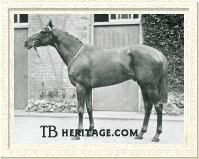
Clarissimus
| |
Radium's most important representative was CLARISSIMUS. Foaled in 1913 and out of the St. Frusquin mare Quintessence, Clarissimus, owned by Lord Falmouth, had the precocity to win the Clearwell Stakes at two and the speed to capture the Two Thousand Guineas at three. He also took the Champion Stakes at Newmarket during his three-year-old season. He placed second in the Newmarket Stakes and the September Stakes. In the latter, the wartime version of the St. Leger, Clarissimus was beaten by Hurry On.
|
At stud, Clarissimus was quite successful. His best son was Nino, winner of the Prix Robert Papin, Prix du Cadran and two runnings of the Prix du Presidente de la Republique. Nino in turn sired Canot, winner of the Prix Jean Prat and Criterium de Saint-Cloud and sire of the filly Imprudence, victress in the English Oaks, One Thousand Guineas and Poule d'Essai des Pouliches; Nica, winner of the Prix du Conseil Municipal; Elseneur, winner of the Grand Prix de Printemps and second in the Prix du Jockey Club; and Come In, winner of the Prix du Conseil Municipal. Nino was broodmare sire of Prix de Diane heroine Montenica, as well as of Djebellica, a winner of the Irish Oaks.
But it was as a broodmare sire that Clarissimus truly excelled. Delleana, a daughter of Clarissimus out of Duccia di Buoninsegna, by Bridge of Earn, was bred in Italy. She was victorious in the Premio Regina Elena (Italian One Thousand Guineas), Premio Paroili (Italian Two Thousand Guineas), and Gran Premio d'Italia. At stud, Delleana bred Donatello, winner of the Criterium Nazionale, Gran Criterium, Derby Italiano, Gran Premio di Milano, and Gran Premio d'Italia and at stud sire of many high class winners, including British champion Alycidon. Donatella, a daughter of Delleana, was champion two-year-old filly in Italy in 1941 and bred two Italian classic winners, Daumier and De Dreux. Another daughter of Delleana was Dossa Dossi, winner of the Oaks d'Italia and Premio Regina Elena.
Vitamine, a daughter of Clarissimus out of Viridiflora, by Sans Souci, captured the Prix Jacques le Marois and at stud bred Brantôme, classic winner in France of the Poule d'Essai des Poulains, Prix Royal-Oak, and Prix de l'Arc de Triomphe and a leading French sire. Vitamine also bred the filly Crudité, victress over males in the Grand Prix de Paris.
Carissima, a daughter of Clarissimus out of Casquetts, by Captivation, was a stakes winner of three races and dam of Pharis, unbeaten winner of the Prix du Jockey Club.
Irish Derby winner Patriot King; Premio Regina Elena winner Beatrice; Premio Regina Elena winner Brunnalesca; stakes winner Grand Marnier; and Formasterus, a French-bred stakes winner who went on to become a highly influential sire in Brazil, were all produced from Clarissimus mares.
Boudoir II, an Irish-bred daughter of Mahmoud out of the Clarissimus mare Kampala, proved important for American breeding. Imported to the United States, she founded a family which has produced Flower Bowl, Bowl of Flowers, Gallant Bloom, Your Host, Coraggioso, classic winners Majestic Prince and Real Quiet, and major sires Graustark and His Majesty.
Clarissimus was Radium's only classic winner. But Radium sired a number of other individuals who, like him, excelled in cup races. CONDOVER, out of the John o' Gaunt mare Moonfleet, was foaled in 1919. His principle victories came in the Coronation Cup, Prix d'Ispahan, and Newbury Spring Cup. Condover was not a successful stallion.
|
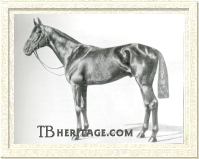
Periosteum
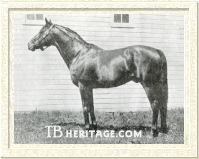
Paragon
| |
PERIOSTEUM, foaled in 1917 and out of the Persimmon mare Persicaria, counted the Ascot Gold Cup among his stakes victories. Though he lived well into his twenties, Periosteum was not a noteworthy sire.
PARAGON was a full brother to Clarissimus and foaled in 1917. He was a classy runner, notching victories in the Duke of York Stakes, Kempton Jubilee, and the City and Suburban Handicap. He was sold to serve stud in the United States, but unlike his brother Clarissimus, achieved no lasting distinction.
APOTHECARY, out of the Right-Away mare Sandpath, was foaled in 1912. His important victories came in the Clearwell Stakes and Newmarket Gold Cup. ILLUMINATOR, out of the Ayrshire mare Ayesha, was a foal of 1917. He was victorious in the Chesterfield Cup and Royal Hunt Cup. He wound up at stud in Poland, where he had some success, coming up with Horyn, winner of the Nagroda Derby and Fatima, winner of the Nagroda Wielka Warszawska.
|
| NIGHT RAID was foaled in 1918 and out of the Spearmint mare Sentiment. Night Raid was a beautifully bred individual, for his dam was out of One Thousand Guineas heroine Flair, a half-sister to Lady Lightfoot, dam of Prince Palatine, winner of the St. Leger and two runnings of the Ascot Gold Cup. Naturally, with such a pedigree, much was expected of Night Raid as a racecourse performer. He failed to live up to expectations when he went winless in six starts in Britain. He was sold and sent to Australia, where he won one race in a further 29 starts, and dead-heated for first in another race. Retired to stud initially in Australia, he served one season, was returned to training, and then retired to stud again, this time in New Zealand. |
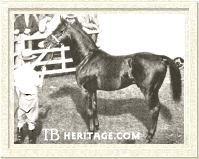
Night Raid
| |
It was through his performance in the breeding shed that Night Raid is remembered. He became an outstanding sire. His offspring included Nightly, winner of the New Zealand Derby, Canterbury Cup, and Moonee Valley Gold Cup; Nightbeam, winner of the AJC Metropolitan, Australian Guineas, and Champagne Stakes; Lady Graceful, winner of the New Zealand Oaks; Night Pilot, winner of the Taranaki Cup; The Cardinal, winner of the Avondale Cup; Aesulus, winner of the Hawke's Bay Cup; Blixten, winner of the Rosehill Guineas; and Pillow Fight, winner of the Avondale Guineas. |
Night Raid's two best were Nightmarch and Phar Lap. The former was a victor in the Melbourne Cup, the AJC Epsom Handicap, the New Zealand Cup, and was a successful sire in his own right. The latter, Phar Lap, is considered the greatest racehorse foaled in Australasia in the 20th century.
Phar Lap was a mammouth chestnut gelding standing over seventeen hands with a stride of 27 feet. He was foaled in New Zealand, but, with the exception of his last start, did all his racing in Australia. Between 1928 and 1932, Phar Lap captured 37 of his 51 races, including the Melbourne Cup. He was sent to America in the spring of 1932 in the hopes of dominating the best American horses as he had his competition down under. The grandson of Radium seemed well on his way to achieving that goal when he captured the Agua Caliente Handicap in easy fashion before his premature death under mysterious circumstances on April 5, 1932.
As a broodmare sire, Radium had daughters who were successful not only in Britain, but in Australia and particularly, the United States. Daughter ECURIE, who was a winner, was the dam of Diligence, a Hurry On colt which captured the Newmarket St. Leger and the Sussex Stakes and later became the broodmare sire of classic filly Sun Chariot. MAGICAL MUSIC produced Knight of the Grail, a winner of the Irish Derby.
DROPPED STITCH, bred in Ireland, was exported to South Africa. There, she became the dam of Meteoros, winner of the South African Derby, Guineas, and St. Leger and Natal Derby. METTLESOME was a daughter of Radium exported to Australasia. There, she became the dam of Cromwell, victor in the Rosehill Guineas.
Several Radium mares were brought to the United States and did very well. LADY CARNOT was out of a full sister to Ascot Gold Cup winner William the Third. She made no mark on the racecourse, but at stud produced Aga Khan, a colt by Kentucky Derby winner Omar Khayyam. Aga Khan was a winner of twelve races, including the Lawrence Realization. Gravitate, a daughter of Lady Carnot sired by Rock View, became the dam of Bay Shore Handicap winner Dominus and second dam of American champion and classic winner Granville.
FATIMA was a Radium mare out of Favilla, by Desmond, and was from the family of leading American sire Star Shoot. She produced stakes winners Inhale and Pasha. The former captured four stakes, including the Youthful, Astoria, and Demoiselle, and the latter was victorious in the Jerome Handicap.
BROCATELLE was a granddaughter of One Thousand Guineas heroine Briar-root. On the racecourse, Brocatelle won once in sixteen starts. As a broodmare in America, she proved exceptional. She produced full siblings by The Porter, the filly Brocado and the colt Toro. The former was a winner of the Adirondack Stakes and placed in the Spinaway Stakes, the latter captured twelve races, including the American Derby and Cincinnati Trophy, was second to Victorian in the Preakness Stakes and third to Reigh Count in the Kentucky Derby. Brocatelle's third major winner was the Neddie colt Good Goods.
Good Goods was a durable performer, capturing ten races, among them the Havre de Grace Handicap. He was also third to Peace Chance in the 1934 Belmont Stakes. Not a fashionable stallion by any means, he did come up with Alsab, champion juvenile colt of 1941 and champion and classic winner of the Preakness Stakes at three.
FAIRY RAY, out of Seraph, by St. Frusquin, was a member of the prolific St. Marguerite family. She was foaled in 1911. Her pedigree made her a highly desirable broodmare prospect, and accordingly, she was purchased by Kentucky breeder Arthur Hancock for his Claiborne Farm near Paris, Kentucky. She produced stakes winner Cloudland, but is chiefly remembered for her non-winning daughter Marguerite.
This filly was sold by Hancock to client William Woodward, master of Belair Stud. For Woodward, Marguerite bred major stakes winner Petee-Wrack, American Triple Crown winner Gallant Fox, and that horse's full brothers, the stakes winners Foxbrough and Fighting Fox.
Radium died at the age of nineteen in 1922. For two years prior to his death he had been almost completely sterile. He was humanely put down at the end of August, 1922, at Southcourt. Unable to win a classic himself, through such as Clarissimus, Night Raid, and Fairy Ray, his classic genes enriched future generations around the world.
--Liz Martiniak
|
|
|
|

